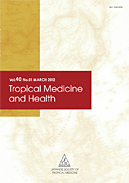Fruits of
Brucea javanica (L.) Merr. (“Ratchadad” in Thai) and roots of
Eurycoma longifolia Jack (“Plalaipeag” in Thai) are used as traditional medicines for the treatment of malarial fever. Ethanol, methanol, ethyl acetate, ethyl alcohol and aqueous extracts were tested against the multidrug-resistant
Plasmodium falciparum strain K1. Ethanol and methanol-ethanol extracts, together with methanol residue, from fruits of
B. javanica (L.) Merr. showed the highest antiplasmodial activities with IC
50 values of 0.5 ± 0.3, 0.3 ± 0.1 and 0.3 ± 0.05 Μg⁄mL, respectively, comparable to the IC
50 values of chloroquine (0.17 ± 0.02 Μg⁄mL) and quinine (0.3 ± 0.1 Μg⁄mL). Similarly, ethanol and methanol-ethanol extracts of roots of
E. longifolia Jack showed higher activities than those of the other solvent extracts, but their activities were about 10-fold lower than those of extracts from
B. javanica (L.) Merr. fruit. In drug combination tests,
B. javanica (L.) Merr. and
E. longifolia Jack extracts did not appear to antagonize antiplasmodial activity of chloroquine and quinine. Not only well-known quassinoid glycosides but also coumarins and flavonoids identified by thin-layer chromatography in ethanol and methanol-ethanol extracts and in methanol residue of
B. javanica (L.) Merr fruit and
E. longifolia roots may be responsible for the antimalarial activity. Taken together, our extraction conditions provided extracts containing novel active compounds that did not antagonize the inhibitory effects of the two widely used antimalarials. This finding could lend support to the future discovery of active antimalaria compounds of
Brucea javanica (L.) Merr. and
Eurycoma longifolia Jack as drugs for the treatment of malaria that could be employed as drug combinations in order to delay the onset of parasite drug resistance.
抄録全体を表示
